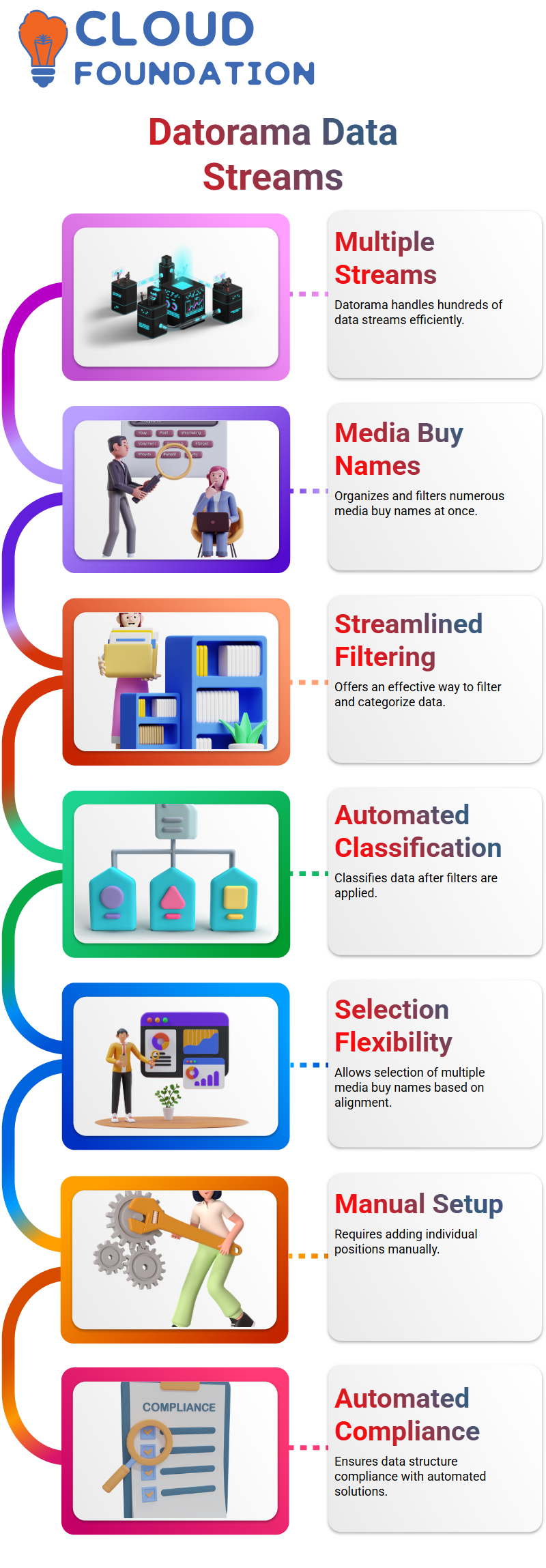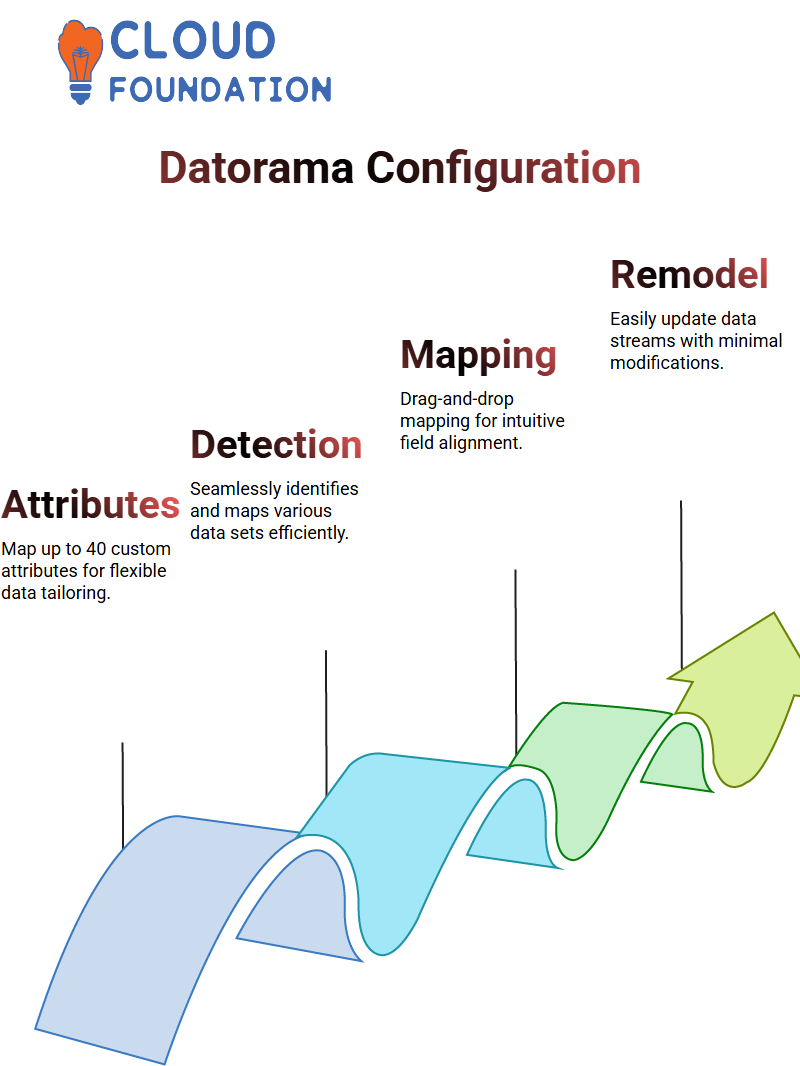How to Use Datorama Patterns for Seamless Data Integration and Classification?
Understanding Patterns in Datorama
Patterns play an integral part in Datorama’s data organisation capabilities.
We utilise them to extract meaningful insights from complex datasets without resorting to extensive coding.
Think of patterns as innovative ways of classifying and bucketing information that make reference and analysis simpler.
Patterns simplify handling large volumes of campaign data by eliminating the need to define variables or write complex formulas manually.
By setting patterns, we can seamlessly categorise attributes such as car name, car category name and promotion name within Datorama without incurring delays caused by manual data input or formula writing.

How to Find and Use Patterns in Datorama
Datorama provides patterns in its Connect and Mix section for quick accessibility, then in its Harmonisation Setup, where these can be defined and utilised to segregate data more effectively and harmonise dimensions more successfully.
Patterns provide an optimal solution when we encounter overlapping elements or inconsistencies in data classification.
Their implementation ensures greater scalability and organisation of our information systems.
Why Datorama Patterns Matter
Imagine managing different data streams within Datorama, each requiring classification, some from media buys and others from campaign details.
Manually handling such diverse information would involve endless formulas requiring tedious attention to detail for its management, rendering manual management cumbersome indeed.
Datorama simplifies classification by recognising recurring structures within data, thus eliminating redundancies and improving visualisation performance, helping prevent crashes and slow load times.
Creating Patterns in Datorama
Establishing patterns within Datorama is straightforward.
Navigate to Harmonisation Centre Patterns and create your new pattern by specifying its name and source dimensions.
To effectively classify media buys, we select their respective attributes from our dataset and assign them to Datorama, enabling it to recognise and categorise data appropriately, thereby increasing automation and accuracy.
Scaling Data Organisation with Datorama Patterns
One of Datorama’s hallmark patterns is its scalability.
We currently manage only two datasets, but this could change dramatically.
In such circumstances, manual formula writing would no longer suffice.
Patterns offer an effective solution by automatically identifying similarities among datasets, thereby creating a smoother workflow without the need for frequent formula updates.
Optimising Data Streams in Datorama
Imagine an environment where different datasets contain similar information but use different naming conventions for it.
For instance, media buy details can be taken directly from media buy records, while campaign records would contain identical information, including publisher details and campaign activity data.
Datorama patterns enable us to easily unify datasets by mapping their structures effectively, regardless of whether their source is media buys or campaigns.
These patterns ensure consistency and precision in classification.
Leveraging Datorama Patterns for Better Performance
Without patterns, data visualisation in Datorama could quickly become slow and ineffective.

A minor change would necessitate recreating formulas, causing unnecessary delays.
Herein lies the potential of patterns of patterns as powerful instruments of data harmonisation.
By creating predefined patterns, we eliminate redundant processing steps and boost system performance.
Data loads faster, visualisations remain stable, and users can interact seamlessly with dashboards.
Understanding Data Streams with Datorama
Datorama requires you to think in terms of multiple data streams when working with it, not just one or two streams at a time, but hundreds.
Think about handling hundreds of media buy names at one time.
How can Datorama organise these effectively?
Datorama offers a streamlined approach for filtering and categorising data streams.
If managing media buys and data streams, filters enable you to select relevant information and refine placements with ease and efficiency.
At the same time, Datorama’s classification process helps organise them on every level of data structure.
Filtering and Classification in Datorama
Datorama offers the flexibility to add filters to data sources and streams, facilitating easier organisation of your workspace.
After applying any filter, Datorama automatically classifies media buy data into distinct categories.
Can select multiple media buy names at once?

Ultimately, that depends on how closely patterns align within your dataset.
If all alignment is perfect, Datorama provides only one selection option at any given point in time.
Manual vs. Automated Setup in Datorama
Datorama offers two setup options: manual and automated.
Manual configuration requires manually adding individual positions.
Datorama’s automated solution simplifies data classification, ensuring compliance and maintaining structural integrity.
Datorama provides a toggle box to indicate whether the data structure meets compliance.
If there are fragmented portions, Datorama enables efficient management of delimiters.
Data Structuring and Naming Conventions in Datorama
Naming conventions play a crucial role in Datorama.
By choosing clear and consistent names from the start, it becomes much simpler to locate and harmonise dimensions on our platform.
Datorama makes structured data processing seamless by providing tools that enable you to organise naming conventions to match harmonised dimensions, ensuring compatibility when visualising data.
Classifying Campaign Components in Datorama
Be mindful when entering data classification, as understanding its purpose can be confusing.
Datorama can help you segment campaign components and media buy names into distinct insights for future use.
Datorama brings these various streams together seamlessly for effective analytics.
Building Effective Data Streams in Datorama
Datorama data streams are organised to efficiently accommodate diverse datasets, such as media buy names or campaign attributes.
Datorama provides efficient filtering and harmonisation capabilities, ensuring effective management and filtering.
Delineating delimiters within Datorama ensures structured data processing, enabling multiple patterns to align for enhanced analytics.
Understanding Datorama and Campaign Patterns
Datorama plays an instrumental role in unifying campaign data.
Working with placement size requires consistency across dimensions to achieve this.
Naming conventions must match as part of this goal, so when data streams merge, they don’t produce discrepancies in column names that could cause mismatching when merging data streams.
Datorama’s Approach to Harmonised Dimensions
Datorama makes harmonised dimensions accessible by creating structured patterns to align campaign and media data appropriately, with seamless merging of data streams while mitigating risks associated with misclassification.

Naming conventions enable seamless merging and reduce the risk of misclassification.
Building Patterns with Datorama
Datorama simplifies data management by establishing clear payment modes of action as part of its data structure, such as medium, country, device, or index dimensions for campaigns, ensuring consistency and seamless extraction without delimiters interrupting the process.
Datorama Enhances Data Visualisation
Once patterns have been set in motion, Datorama makes it simple and effective for users to visualise data.
Each campaign dimension, such as medium pattern, country code pattern, or device pattern, can appear as separate columns.
Users may then create bar graphs or area charts as needed to analyse trends efficiently.
Ensuring Structure Compliance with Datorama
Data Structure Compliance plays a pivotal role in campaign classification.
Datorama helps ensure misalignments don’t occur by mandating uniform conventions across media streams and services.

When data Structure Compliance is disabled, misclassified information surfaces, underlining its importance.
Datorama and Taxonomy Governance
Taxonomy governance ensures campaign naming conventions adhere to predefined standards.
Agencies and clients alike must synchronise their taxonomies when developing campaign structures.
Datorama helps rectify errors caused by transition phases or inconsistencies.
Combining Data Classification with Datorama
Datorama provides structured patterns to complement data classification, enhancing campaign analysis.
They work in harmony to eliminate inconsistencies and to improve accuracy in media data classification.
Working with non-compliant data provides Datorama with an organised way of managing it all.
Understanding Datorama’s Mapping Process
Receive data from your account manager, but the new file contains incorrect lowercase letters for Media by Key.
Datorama’s case sensitivity fails to ingest it properly.
To circumvent this problem, Datorama’s Colleagues function helps map old column data onto new ones in such a way that Datorama recognises them both as identical and processes the information seamlessly.
Connecting and Mixing Data in Datorama
Datorama provides tools that make connecting, mixing, analysing, acting on, and visualising data effortless.
Suppose it needed to upload files using the Total Connect feature, which allows me to drag and drop a file to generate a preview screen.
Any adjustments required, such as naming datasets or formatting numbers and text, can be handled effortlessly with Datorama’s intuitive user interface.
Custom Attributes in Datorama
Datorama’s custom attributes can be game-changers.
Can quickly map columns like Placement Dimension and Identity into these attributes for mediation purposes, then tailor my dataset according to specific requirements.
Providing up to 40 custom attributes per entity offers unprecedented flexibility.
Optimising Data Sets with Datorama
Datorama stands out with its data set recognition capabilities.

Regardless of whether it’s advertisements, search keywords, web analytics data sets, or anything in between, Datorama recognises all forms of data sets seamlessly and suggests mapping fields appropriate to each data stream type.
Should I change data streams later on in a seamless manner, with only minor adjustments required to update placeholders and conform to new structures?
Streamlined Mapping Experience in Datorama
Datorama makes mapping easy: the left-side columns display raw data while the right-side ones present Datorama model fields for which I drag-and-drop values for accurate mapping.
Furthermore, should any adjustments need to be made later on or if unmapping is required altogether, Datorama makes that task simple too.
Datorama Mapping and Custom Attributes
How does Datorama enable users to map entity attributes effectively?
Once you know which attributes qualify as part of an entity, they can be effortlessly converted to custom attribute columns, which even makes formulae easier.
Once the habit forms, it becomes second nature.
As part of your mapping endeavours, it’s critical that you carefully consider your data model.
Regardless of whether it involves one-to-one relationships, one-to-many, or many-to-many relations, being mindful of these strategies pays dividends over time, and Datorama makes this process effortless.
Datorama Data Verification and Field Mapping

Map or unmap fields as necessary to identify unmapped ones.
When there are unmapped fields that require attention, using font layers enables Datorama users to easily create custom fields as needed for custom field creation, writing formulas, and mapping devices.
Datorama Calculated Measurements and Native Columns
Have you ever created calculated dimensions or measurements before?
In Datorama, calculated measures can be made at the workspace level and apply universally. Imagine needing to highlight CPC calculations using clicks and impressions.
Drag that calculated measurement from your workspace into your data set.
Datorama Campaign Data Updates
Datorama provides an outstanding firsthand glimpse at your campaigns via its pivot table, offering a fantastic view.
Here, you can select and name your campaign before applying it, while also gaining key insights, including campaign keys, media costs, and tokens.
It’s like getting an inside peek into what’s going on behind the scenes of your data.
Datorama Automation Features
Let’s talk about automation in Datorama: you can set up an FTP domain with your credentials for regular data ingestion, whether weekly, bi-monthly, or monthly.
Automating data pushing and retrieval makes life much simpler.
Datorama: Unlocking Automation with Cloud Storage
How cloud storage and drives can play a crucial role in automating data workflows, utilising Datorama tools to streamline processes as never before.
What strikes me most about Datorama is its seamless integration with various data sources.
Think cloud storage at your disposal with easy automation capabilities that’s Datorama at its finest, turning complex information into actionable insights.
Datorama has revolutionised my approach to data automation.
Thanks to cloud storage and drive functionality, Datorama enables fast and effective automation across various data types.

Its ease in managing large amounts of information makes managing vast quantities incredibly straightforward.
Datorama makes starting your automation journey easy.
From cloud storage and drives, Datorama ensures a seamless user experience throughout your entire automation journey.
With Datorama’s help, automate data workflows without technical limitations or hindrances.
Its cloud storage abilities, combined with the automation of all my data, are an incredible boon to productivity.

Sai Susmitha
Author



